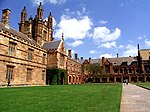Frontiers of Science
Frontiers of Science was an illustrated comic strip created by Professor Stuart Butler of the School of Physics at the University of Sydney in collaboration with Robert Raymond, a documentary maker from the Australian Broadcasting Corporation (ABC) in 1961.[1] The artist was Andrea Bresciani.[2] After 1970 the comic was illustrated by David Emerson.[3]
It explained scientific concepts and recent research and in a 3 or 4 panel illustrated strip in an accessible and easily comprehensible way. The strip was syndicated to over 200 newspapers around the world for 25 years, from 1961 to 1987.[4] It was also published as soft cover books. As of 2011, it "retains the record of being the longest-running newspaper science comic strip in the world."[5]
The strips are archived at Rare Books and Special Collections in Fisher Library at the University of Sydney. The entire series is available for viewing online. [6][7]

References
[edit]- ^ Australian Academy of Science Archived 2008-07-22 at the Wayback Machine Biographical Memoirs - Stuart Thomas Butler 1926-1982 . Accessed March 2008.
- ^ Andrea Bresciani Archived 2007-11-03 at the Wayback Machine An Artist between Two Worlds By Giuseppe Trovato. Accessed March 2008.
- ^ Holtz, Allan (2015). "Stripper's Guide: Obscurity of the Day: Frontiers of Science". Stripper's Guide. Retrieved 2019-04-26.
- ^ Leach, Joan; Burns, Maureen (2009). "Frontiers of Science Communication | Issues Magazine". www.issuesmagazine.com.au. Retrieved 2019-04-26.
- ^ Burns, Maureen; Leach, Joan (2011-09-01). "Science as an extra dividend: Frontiers of Science". International Journal of Cultural Studies. 14 (5): 531–546. doi:10.1177/1367877910382190. ISSN 1367-8779. S2CID 145566058.
- ^ "Frontiers of Science". The University of Sydney. 2019.
- ^ Slezak, Michael (2009-10-28). "When science took a long, light look at itself". The Sydney Morning Herald. Retrieved 2019-04-26.
External links
[edit]- Drifting Through Inner Space Ocean deep exploration explained in 5 cartoon strips c late 1960s - at NASA website - Accessed July 2006.
- University of Sydney Outreach projects, Frontiers of Science, - Accessed July 2006.
- Frontiers of Science Digital Collections, University of Sydney - Accessed April 2019.

